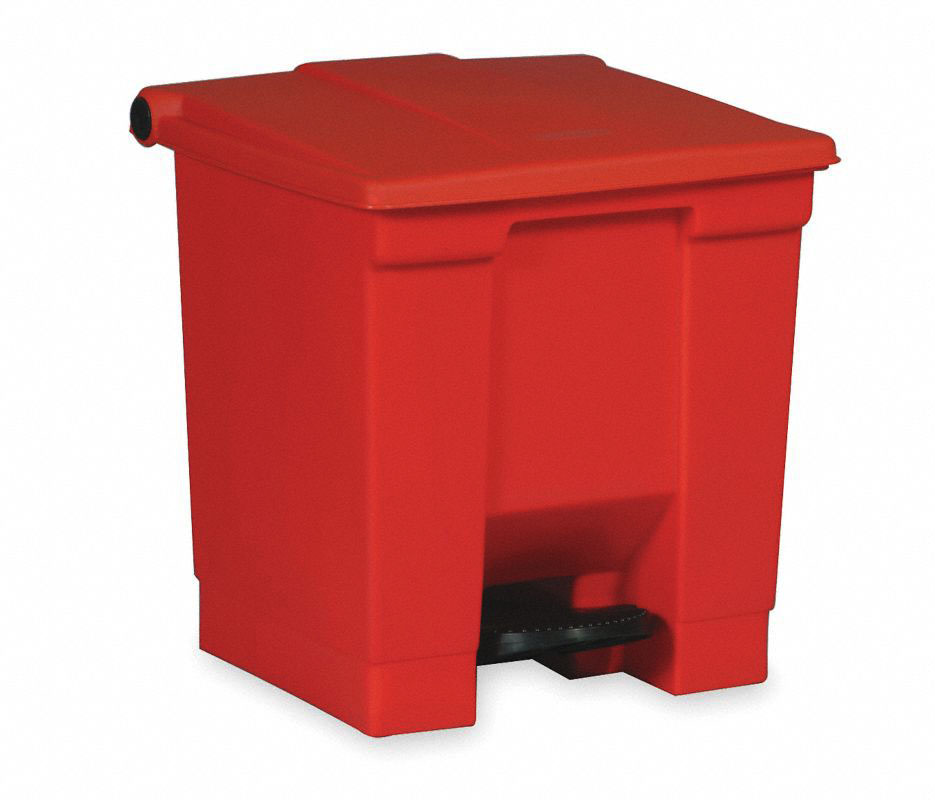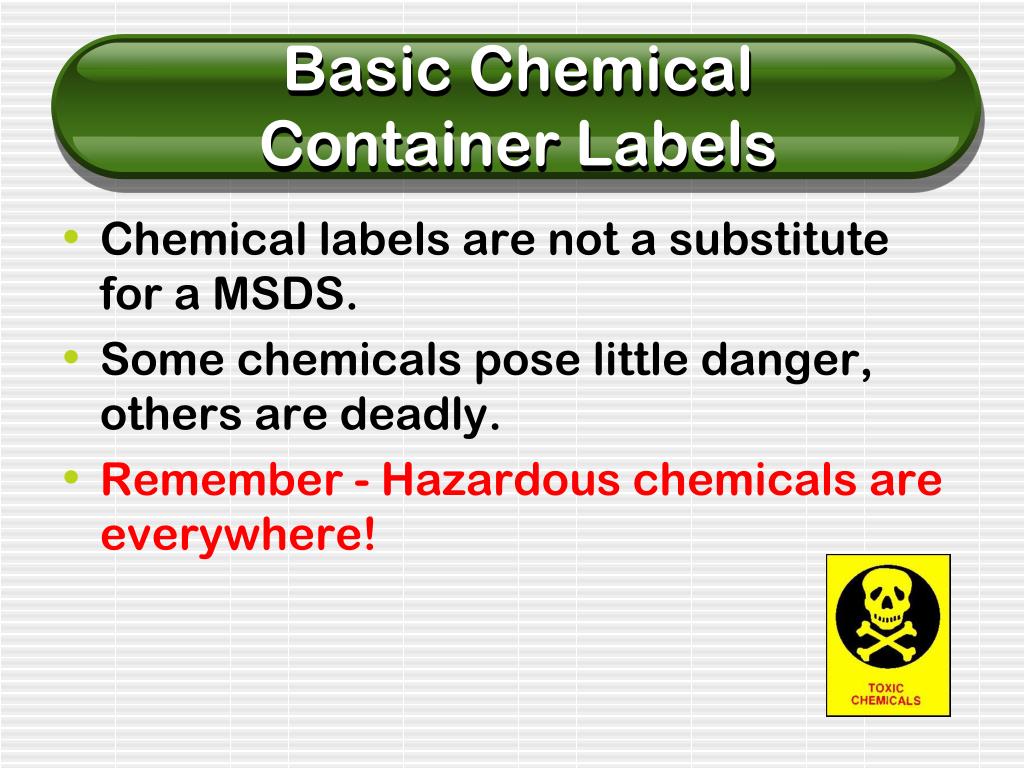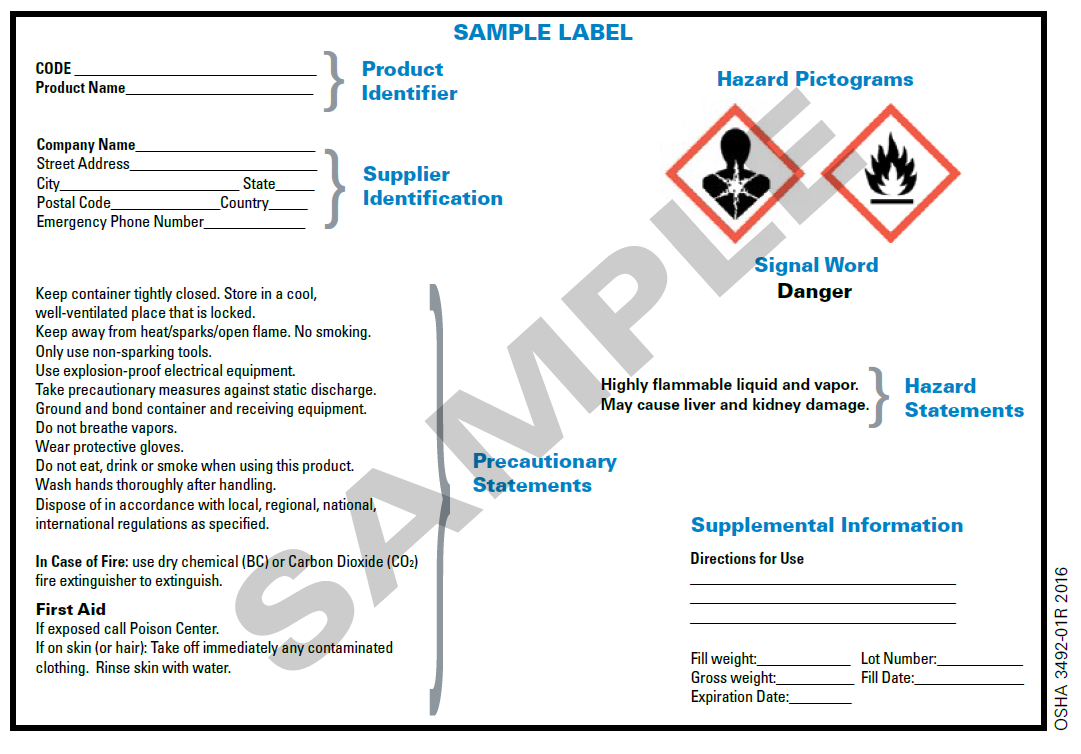42 standard labels for chemical containers
PDF Chemical Container HCS 2012 Labeling • All hazardous chemical containers must be labeled. • A container means any bag, barrel, bottle, box, can, cylinder, drum, reaction vessel, storage tank, or the like that contains a hazardous chemical. • Container labels must meet either Hazard Communication Standard (HCS) 2012 or Consumer Product PDF HEALTH & SAFETY Chemical Container Labeling Hazardous chemical containers used within a Laboratory Area must follow the OSHA Laboratory Standard. Hazardous chemical containers used within a Non-Laboratory Area must follow the OSHA Hazardous Communication ... o Label the outside of the container with approximate contents if feasible or list where more information can be
PDF BRIEF - Occupational Safety and Health Administration revised standard. Distributors may continue to ship containers labeled by manufacturers or importers (but not by the distributor themselves) in compliance with the HazCom 1994 until December 1, 2015. This document is designed to inform chemical receivers, chemical purchasers, and trainers about the label requirements. It explains the

Standard labels for chemical containers
PDF Toolbox Talk #5 Secondary Chemical Containers manufacturer-provided container. Some of the major requirements of the OSHA hazard communication standard that are intended to protect employees in the workplace include: • All containers of hazardous products must be clearly labeled. • Never remove labels from containers. This includes labels on cans, boxes, bags, Mysteries of HazCom Labels Solved- KHA Online-SDS Management Secondary container labeling can be tricky to navigate due to certain exclusions included in the HazCom standard. The simplest way to be certain you're in compliance is to always label secondary chemical containers with full GHS labels. Below are some use case scenarios for your consideration. Take the Mystery Out of Your Chemical Container Labeling The yellow mystery liquid could also have been a highly toxic chemical. Since the container wasn't labeled, workers in that area didn't have enough information to handle it safely, and were at risk of mistakenly ingesting a chemical that could lead to serious injury or even a fatality. OSHA's HazCom Standard, which is currently aligned ...
Standard labels for chemical containers. Labeling of Secondary Containers | Occupational Safety and Health ... Scenario: Your company purchases secondary containers for chemicals, which are bottles with pre-printed (embossed) labels that contain a specific chemical name (e.g., methanol, acetone), National Fire Protection Association (NFPA) diamond, and health and physical hazard pictograms. The labels do not include the manufacturer's name and address ... PDF Secondary Container Labeling another container, the container you transferred into is called a secondary container. Any bag, barrel, bottle, box, can, cylinder, drum, reaction vessel, storage tank, tank truck or the like that contains a hazardous chemical is considered to be a container. 8 CCR 5194 Original Bottle "Incoming Container" Secondary Containers 4 Quick Tips to Help You Ace OSHA Secondary Container Labeling Secondary Container Labeling Summary. These four simple tips can help you create compliant labels for secondary containers. Make sure you get OSHA-compliant Safety Data Sheets from your chemical supplier. Play it safe and create GHS labels for all chemical containers in your facility. If simply printing a few extra labels helps you avoid an ... Chemical Labeling | Environmental Health & Safety Chemical Labeling. Under the Cal-OSHA Hazard Communication Standard (CCR, Title 8, 5194) all chemical containers must be properly labeled - unless a material is temporarily put into a new container for immediate use and is not going to be stored after that immediate use. Labeling requirements for all hazardous substances are summarized as ...
Everything You Need to Know About Labeling Secondary Containers - LEM Labeling secondary containers can reduce the number of accidents in the workplace and protect worker health and safety. Examples of secondary containers include: Storage bottles used for distributing small amounts of the chemical. Storage bottles used to dilute the chemical. Spray bottles. Beakers, test tubes, or vials. PDF Chemical Labeling Standard for Secondary Containers Chemical Labeling Standard for Secondary Containers 7.2 References: National Research Council of the National Academies, Guide for the Care and Use of Laboratory Animals, 8th edition National Research Council, Institute of Laboratory Animal Resources, Occupational Health and Safety in the Care and Use of Research Animals, 1997 Chemical Labelling Requirements | Environmental Health & Safety ... Labels on purchased chemicals must include: The common name of the chemical. The name, address and emergency phone number of the company responsible for the product. An appropriate hazard warning. The warning may be a single word - "danger", "warning" and "caution" - or may identify the primary hazard, both physical (i.e., water ... PDF Labels Under the Texas Hazard Communication Act communication. The chemical identifier on all hazardous chemical containers must match the chemical identifier on the SDS. Also, the Workplace Chemical List (WCL) must use the identity used on the SDS and the container label. (Inclusion on the WCL is required only for those hazardous chemicals that meet or exceed the 55 gallon or 500-pound ...
Labeling secondary containers - J. J. Keller® Safety The hazard communication ("HazCom") standard at 1910.1200(f)(8) says, in part, "the employer is not required to label portable containers into which hazardous chemicals are transferred from labeled containers, and which are intended only for the immediate use of the employee who performs the transfer." If the chemical is used in the same shift ... GHS Labeling Requirements: The Definitive Guide [2021 Update ... - Luminer Therefore, at this time, every company that labels containers storing chemicals must follow HazCom 2012's rules. While GHS standards are only a guideline, HazCom 2012 is a legal mandate. ... All hazardous chemical labels must be made with six different indicators. These GHS label requirements are meant to succinctly communicate key ... OSHA Letter of Interpretation limits small container ... - Labelmaster Under the revised standard, labels on shipped containers must display the following information at a minimum: Product Identifier (Name of Chemical) Manufacturer (Responsible party) contact information; Pictogram(s) visually representing the hazard(s) of the chemical; A signal word stating the level of risk ("Danger" or "Warning") Chemical Container Labels | EHS Read the Hazard Communication Standard for Labels and Pictograms for more information about original container label requirements. Contact EH&S at 206.543.7388 or ehsdept@uw.edu for assistance in preparing a replacement label. Secondary chemical container labels
Container Labeling | Office of Environmental Health and Safety | ECU The revised standard requires that information about chemical hazards be conveyed on labels using quick visual notations to alert the user, providing immediate recognition of the hazards. ... altered or defaced. If a chemical container's original label must be replaced, the new label must contain the same information as the original. Only use ...
ohs-workplacelabels | Environmental Health & Safety | Washington State ... Workplace Labels for Chemicals. Washington Administrative Code (WAC) 296-901, Hazard Communication Standard, states that all hazardous chemical containers in the workplace must be labeled.This includes secondary, or workplace, containers into which chemicals have been transferred from the shipped, or manufacturer's container (e.g. cleaners/disinfectants transferred to spray bottles).
4 Evaluating Hazards and Assessing Risks in the Laboratory | Prudent Practices in the Laboratory ...
Safety Labels for Hazardous Chemicals | NSTA The OSHA Laboratory Standard 29 CFR 1910.1450 details specific recommendations when labeling and storing hazardous chemicals within school laboratories. First of all, the laboratory standard [ (1910.1450 (h) (1) (i)] requires that labels on incoming containers not be removed or defaced. Incoming container refers to the original receptacle that ...
Intro to Hazard Communication, Part Three: Labeling Requirements A big reason for the lack of information is that chemical containers often weren't labeled, or had labels that had incomplete or poorly organized information. That's why the HazCom standard includes strict labeling requirements, and it's also why OSHA opted to revisit and improve those requirements by aligning with the Globally Harmonized ...
PDF Hazard Communication Standard: Labels and Pictograms Communication Standard (HCS/HazCom 1994 1) from a performance-based standard to one that has more structured requirements for the labeling of chemicals. The revised standard requires that information about chemical hazards be conveyed on labels using quick visual notations to alert the user, providing immediate recognition of the hazards. Labels
PDF OSHA Citation: Unlabeled Chemical Containers labeled with the chemical name and appropriate hazard warnings (immediate use containers are excluded from this requirement). Any time a regulatory agency comes to your work area to do an inspection, immediately notify University Health and Safety at (612) 626-6002. Additional information: OSHA Quickfacts chemical labeling and transfer
Chemical Container Labeling | OSHA HCS Labels | Safety Blog The Hazard Communication Standard (HCS) describes chemical labels as information provided through a group of written, printed, or graphic appropriate elements concerning a hazardous chemical. These should be that placed on the immediate container of a hazardous chemical. The Hazard Communication Standard also is now known as the Right to ...
Download secondary chemical container labels | EHS If your laboratory uses secondary containers filled with chemicals, the secondary containers must comply with OSHA's Hazard Communication Standard for Labels and Pictograms. For your convenience, EH&S designed secondary chemical labels that can be downloaded from our website and printed onto Avery 5163 labels. You may choose from three designs:
PDF Chemical Container Labels - EMC Ins a container. Labels, placards or signs can be placed on shelving or posted where similar stationary containers are stored. Although not required, labeling of transfer containers is highly recommended. Signal Words In order to communicate a chemical's hazard severity, the label may have one of these signal words: No signal words - for less ...
Take the Mystery Out of Your Chemical Container Labeling The yellow mystery liquid could also have been a highly toxic chemical. Since the container wasn't labeled, workers in that area didn't have enough information to handle it safely, and were at risk of mistakenly ingesting a chemical that could lead to serious injury or even a fatality. OSHA's HazCom Standard, which is currently aligned ...
Mysteries of HazCom Labels Solved- KHA Online-SDS Management Secondary container labeling can be tricky to navigate due to certain exclusions included in the HazCom standard. The simplest way to be certain you're in compliance is to always label secondary chemical containers with full GHS labels. Below are some use case scenarios for your consideration.
PDF Toolbox Talk #5 Secondary Chemical Containers manufacturer-provided container. Some of the major requirements of the OSHA hazard communication standard that are intended to protect employees in the workplace include: • All containers of hazardous products must be clearly labeled. • Never remove labels from containers. This includes labels on cans, boxes, bags,




![GHS Labeling Requirements: The Definitive Guide [2021 Update] | Luminer](https://www.luminer.com/wp-content/uploads/2017/07/GHS-Definitive-Guide-header-image.png)



Post a Comment for "42 standard labels for chemical containers"